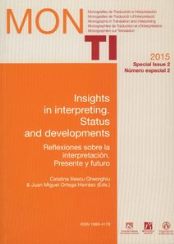Designing role-play models for Telephone Interpreting training
Main Article Content
Abstract
Downloads
Article Details
The documents contained in these directories are included by the contributing authors as a means to ensure timely dissemination of scholarly and technical work on a non-commercial basis. It is understood that all persons copying this information will adhere to the terms and constraints invoked by each author's copyright. These works may not be reposted without the explicit permission of the copyright holder.
References
Couper-Kuhlen, Elizabeth. (2009) “Prosody.” En: D’Hondt, Sigurd; JanOla Östman & Jef Verschueren (eds.) 2009. The Pragmatics of Interaction. Amsterdam: John Benjamins, pp. 176-189.
Fernández Pérez, María Magdalena. (2011) “Variedades de exercicios de roleplay como ferramenta didáctica na formación de intérpretes para os servizos públicos.” En: Cruces Colado, Susana; Maribel del Pozo Triviño; Ana Luna Alonso & Alberto Álvarez Lugrís (eds.) 2011. Traducir en la frontera. Granada: Atrio, pp. 161-169.
Fernández Pérez, María Magdalena. (2012) Identificación de las destrezas de la interpretación telefónica. La Laguna: Universidad de La Laguna. Trabajo de investigación conducente al DEA inédito.
Fowler, Yvonne. (2007) “No More Role Plays, Please-We’re British: Devising Workshops on Working through an Interpreter for Police, Social Workers and Probation Officers.” Versión electrónica: http://criticallink.org/wp-content/uploads/2011/08/CL2_Fowler.pdf.
Gentile, Adolfo; Uldis Ozolins & Mary Vasilakakos. (1996) Liaison Interpreting: A Handbook. Melbourne: Melbourne University Press.
Hale, Sandra. (2004) The Discourse of Court Interpreting. Amsterdam: John Benjamins.
Kelly, Nataly. (2007) “Telephone Interpreting in Health Care Settings: Some Commonly Asked Questions.” The ATA Chronicle 36:6, pp.18-21.
Kelly, Nataly. (2008) Telephone Interpreting. A Comprehensive Guide to the Profession. Bloomington: Trafford Publishing.
Hymes, Dell. (1974) Foundations in Sociolinguistics. An Ethnographic Approach. Londres: Routledge.
Motos Teruel, Tomás. (2005) “Elementos para la creación de un texto dramático.” Revista Recre@rte 3. Versión electrónica: http://www.iacat.com/revista/recrearte/recrearte03/Motos/creacion_drama.htm
Nord, Christiane. (1991) Text Analysis in Translation. Theory, Methodology, and Didactic Application of a Model for Translation-Oriented Text Analysis. Amsterdam: Rodopi B.V.
Rosenberg, Brett Allen. (2007) “A Data Driven Analysis of Telephone Interpreting.” En: Wadensjö, Cecilia; Brigitta Englund-Dimitrova & AnnaLena Nilsson (eds.) 2004. The Critical Link 4: Interpreters in the Community. Selected Papers form the 2nd International Conference on Interpreting in Legal, Health, and Social Service Settings, Stockholm, Sweden, 20-23 May 2004. Amsterdam: John Benjamins, pp. 65-76.
Schegloff, Emanuel. (1996) “Turn Organization: One Intersection of Grammar and Interaction.” En: Ochs, Elinor; Emanuel Schegloff & Sandra Thompson (eds.) 1996. Interaction and Grammar. Cambridge: Cambridge University Press, pp. 52-133. Versión electrónica: http://icar.univlyon2.fr/ecole_thematique/tranal_i/documents/org_tours/sche96_turn_organization.pdf [Consultado el 4 de junio de 2012]
Solís, Mariana. (2011) “Role playing como herramienta de enseñanza.” Reflexión académica en diseño y comunicación 13:19, pp. 70-71.
Tebble, Helen. (1998) Medical Interpreting. Improving Communication with your Patients. Victoria: Deaking University.
Tebble, Helen. (2009) “What can interpreters learn from discourse studies?” En: Hale, Sandra; Uldis Ozolins & Ludmila Stern (eds.) 2009. The Critical Link 5: Quality in Interpreting: A Shared Responsibility. Amsterdam: John Benjamins, pp. 201-220.
Varios autores. (2009) NAJIT Position Paper. Telephone Interpreting in Legal Settings. Versión electrónica: http://www.najit.org/publications/ Telephone%20Interpreting.pdf
Wadensjö, Cecilia. (1998) Interpreting as Interaction. Londres & Nueva York: Longman.


